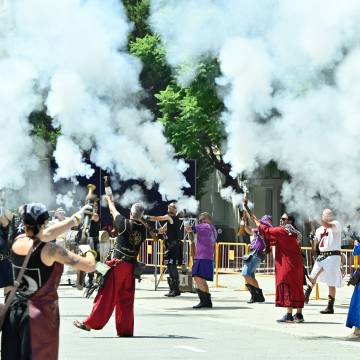August 16th
On August 16, the reconquest begins with the landing of Christian troops. It is the final act of the Moors and Christians Festival, where the forces of the Christian captain arrive in the city with the aim of wresting it from the opposing side. The Battle of Musketry and, ultimately, the Miracle of the Fog mark the moment when the Christians once again conquer Dénia with the intervention of Saint Roch.
Just like for the landing, the Federation of Moors and Christians of Dénia is in charge of the event and stages the theater, both during the Battle of Musketry and for the Miracle of the Fog and the subsequent surrender.
The Reconquest or The Battle of Musketry
Historical records indicate that there was no landing or battle to conquer Dénia. After the fall of Valencia in 1232, other localities gradually surrendered. In 1244, King James I of Aragon sent Pedro Eximen Carroz with his troops to conquer Dénia. The troops traveled by land, which was more economical than by sea, and there was a surrender following a prior agreement between the Christian and Muslim forces.
The Battle of Musketry in the Moors and Christians Festival should be understood as a representation of all the skirmishes and battles fought by Christians to reclaim what they consider their territory. It represents the final confrontation with impressive explosions and abundant smoke.
But in these festivities, before the battle, Moorish and Christian ambassadors intervene on either side of the "castle" gates in an attempt to reach a peaceful agreement.
Inside the castle, the captain and leaders of the Moorish side face a Christian delegation on the other side of the city wall. The parliament takes place, during which both parties try to convince the other to take or not take the city. But it is also the moment when each side presents their glories, history, and religion. This is when the Christian general prevails and urges the Moorish captain to surrender the castle.
As no agreement is reached, the Christians charge. The Moors repel all attacks with muskets, in a reenactment performed by participants, both actors and festival participants.
Note:
Muskets are ancient firearms, similar to rifles, that were fired by igniting gunpowder with a movable fuse attached to the weapon. This is why festival participants can be seen smoking cigars, used to light the musket's fuse.
The use of gunpowder and fireworks in Dénia was a practice reserved for special occasions to enhance their solemnity, and it was usually carried out from the castle itself. Records document this tradition in Dénia from the early 17th century, and possibly even earlier, being particularly prominent during the festivities of the Mare de Déu and Sant Roc, precisely the saint commemorated alongside the modern Moors and Christians celebration.
The Miracle of the Fog
The Miracle of the Fog represents the reconquest of Dénia by the Christians. Despite their efforts, they couldn't seize the city from the Moorish side, so they turned to the patron saint for help. This episode is known as the Miracle of the Fog.
According to the legend, facing the impregnable fortress of the castle, the Christians invoked Saint Roch to support them in battle. On August 16, a dense fog rose from the sea, enveloping the entire castle. This fog allowed the Christians to elude the defenses, as the Moorish lookouts couldn't see, enabling the Christians to enter and conquer the castle. This is how the reconquest took place. Through the prayers of the Christian side, Saint Roch brought about this providential fog for the Moors and crucial for the Christians. The Moorish side was defeated and forced to abandon the city.
As a culmination of the festivities, all Christians form a passage, allowing the Moors to leave the city through that passage. The final retreat takes place at night, marking the conclusion in a more informal manner with a final shot from the blunderbuss. When the captains of each faction fire the last blunderbuss shot, the festivities are concluded.


